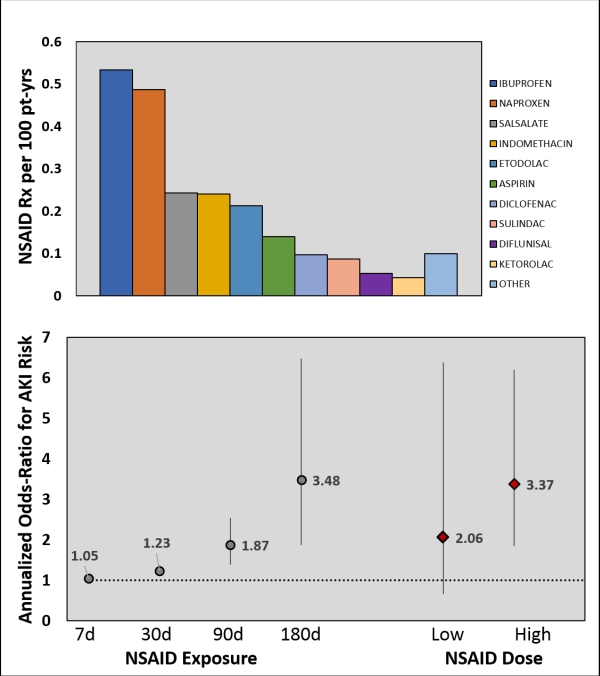Comprehensive Assessment of NSAID Use and Potential Nephrotoxicity Risk in Adult Veteran Kidney Transplant Recipients
Ralph H Johnson VAMC, Charleston, SC.
Meeting: 2018 American Transplant Congress
Abstract number: D81
Keywords: Adverse effects, Glomerular filtration rate (GFR), Kidney transplantation
Session Information
Session Name: Poster Session D: Kidney Complications: Late Graft Failure
Session Type: Poster Session
Date: Tuesday, June 5, 2018
Session Time: 6:00pm-7:00pm
 Presentation Time: 6:00pm-7:00pm
Presentation Time: 6:00pm-7:00pm
Location: Hall 4EF
Background: NSAID use is generally recommended to be avoided in kidney transplantation (KTX), but there is paucity in the studies assessing their safety within this population. This study aims to use a large cohort of Veterans Affairs (VA) KTX recipients to assess the risk of acute kidney injury (AKI) with NSAID use.
Methods: Ten-year longitudinal cohort study of adult KTX recipients with follow up in the VA system from 2001-10. NSAID prescriptions, patient characteristics and eGFRs were abstracted from the VA comprehensive EHR. NSAID exposure was assessed with two methods: proportion of days covered (PDC) by NSAID prescriptions and by high or low dose categories defined by recommended daily prescribing limits. NSAIDs were also categorized by class to assess for differing rates of nephrotoxicity. AKI events were defined by a ≥50% acute rise in creatinine. Risk was estimated using longitudinal multivariable generalized proportional odds modeling.
Results: 5,100 patients were included in the cohort with a total of 29,980 years of patient follow up; 671 NSAID prescriptions were dispensed in 273 (5.4%) patients (2.24 per 100 patient-yrs), with 472 (70%) being high dose. Ibuprofen and naproxen were the most commonly prescribed NSAIDs (Top Figure). High dose NSAID use was associated with 3.4 (1.8-6.2, p<0.001) higher odds of increasing AKI events, while low dose was not significantly associated with AKI (OR 2.1 [0.7-6.4; p=0.219). Length of NSAID use was also strongly associated with higher odds of increasing AKI events (Bottom Figure). One 7-day NSAID course in a year was associated with 5% higher odds of increasing AKI events, while chronic use (≥180 days) was associated with 3.5 (1.9-6.5; p<0.001) higher odds of AKI. Risk of AKI was similar across all NSAID types (OR 2.6[1.9-3.6]; p<0.001), with the possible exception of sulindac (OR 1.2 [0.2-8.56; p=0.865).
Conclusion: NSAID use was uncommon in this cohort of adult veteran KTX recipients, but was associated with a significant increase in the risk of AKI, for both higher NSAID dose and longer duration. Further studies are warranted to assess the potential safety of sulindac in this population.
CITATION INFORMATION: Chiasson J., Fominaya C., Gebregziabher M., Taber D. Comprehensive Assessment of NSAID Use and Potential Nephrotoxicity Risk in Adult Veteran Kidney Transplant Recipients Am J Transplant. 2017;17 (suppl 3).
To cite this abstract in AMA style:
Chiasson J, Fominaya C, Gebregziabher M, Taber D. Comprehensive Assessment of NSAID Use and Potential Nephrotoxicity Risk in Adult Veteran Kidney Transplant Recipients [abstract]. https://atcmeetingabstracts.com/abstract/comprehensive-assessment-of-nsaid-use-and-potential-nephrotoxicity-risk-in-adult-veteran-kidney-transplant-recipients/. Accessed December 7, 2025.« Back to 2018 American Transplant Congress

